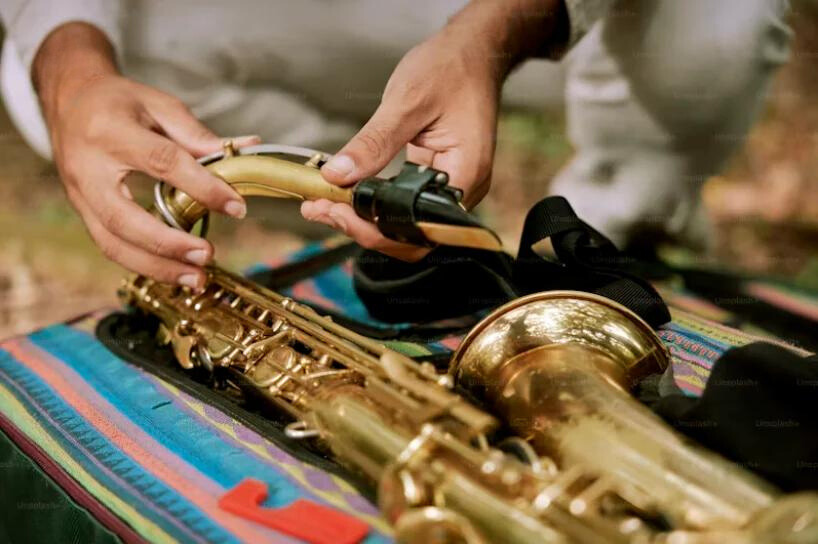The Evolution of the Saxophone
The evolution of the saxophone is a fascinating history that blends individual creativity, industrial technology, musical needs, and cultural trends. From its birth in the mid-19th century to the present day, it has undergone a metamorphosis from a laboratory invention to a global phenomenon, becoming an indispensable sound in classical, jazz, pop, and many other musical styles.
Here are the main stages and key points of its evolution:
-
Birth and Invention (1840s):
-
Inventor: Belgian instrument maker Adolphe Sax.
-
Original Intent: Sax aimed to create an instrument that could fill a tonal gap in orchestras and military bands of the time. He wanted an instrument combining the flexibility and expressiveness of woodwinds (like the clarinet) with the power and projection of brass instruments (like the horn).
-
Core Design: He adopted the single-reed mouthpiece principle of the clarinet but used a conical metal body (similar to the oboe's bore) and fitted it with a key system resembling woodwinds. This unique combination produced the iconic "saxophone sound."
-
Patent: Sax patented his family of "saxhorns" (later known as saxophones) in France in 1846. The original family included instruments from soprano to contrabass.
-
-
Early Development and Military Band Adoption (1840s - 1880s):
-
Military Band Push: The saxophone initially found its main application in French and Belgian military bands. Its powerful volume, rich tonal palette, and good performance in outdoor environments led it to quickly replace some traditional instruments (like the serpent and ophicleide) in military music.
-
Initial Classical Attempts: Some classical composers began experimenting with the saxophone, such as Berlioz (a staunch supporter of Sax), Bizet (L'Arlésienne Suite), Saint-Saëns, and Massenet. However, it did not establish itself as firmly in the symphony orchestra as it did in military bands, remaining relatively marginal for a long time.
-
Early Instrument Characteristics: Key systems were relatively simple (predominantly closed-hole keys), the range might have been narrower than modern instruments, and manufacturing techniques were continually improving.
-
-
Mechanical Refinement and Deepening in Classical Music (1880s - 1920s):
-
Mechanical Innovations: Through the continued efforts of Adolphe Sax and his son Adolphe-Edouard, the saxophone's mechanical structure was significantly improved. The addition of the high F# key and refinements to the octave key mechanism made playing more convenient and intonation more stable.
-
Manufacturing Hub Shift: Paris, France, became the center of saxophone manufacturing, with companies like Selmer Paris beginning to emerge and continuously drive the instrument's development.
-
Expansion in Classical Music: The saxophone's use in classical music gradually increased, particularly in solo works, chamber music, and more adventurous orchestral pieces (like Ravel's Boléro, Prokofiev's Romeo and Juliet). Important works were composed for it by Debussy, Ibert, and Glazunov. The saxophone quartet format also began to develop.
-
-
The Jazz Age Revolution and Popularization (1920s - 1950s):
-
Jazz as the Catalyst: This was the most crucial turning point in saxophone history. The saxophone's unique sound – capable of lyrical singing one moment and explosive improvisation the next – perfectly suited the demands of jazz (especially Swing and Bebop).
-
Rise to Prominence: The saxophone (particularly alto and tenor) rapidly supplanted the clarinet as the core melody and improvisational instrument in jazz bands. Era-defining saxophone masters emerged, like Sidney Bechet (soprano), Coleman Hawkins, Lester Young, Charlie Parker, John Coltrane, and Sonny Rollins.
-
Manufacturing Boom and Design Standardization: Huge market demand spurred a boom in saxophone manufacturing. American makers like Conn, Buescher, King, Martin produced vast quantities (now prized as "vintage saxes"). French Selmer continued innovating, with its iconic Mark VI model (1954-1974) still revered by many players as the gold standard. The basic design and key layout of the modern saxophone matured and became standardized during this period.
-
Materials and Finishes: Brass remained the dominant material, with surface finishes (gold plating, silver plating, lacquer) becoming more diverse and refined.
-
-
Modern Development and Diversification (1960s - Present):
-
Pervasive Across Genres: The saxophone has long transcended classical and jazz, deeply integrating into rhythm & blues, rock, funk, soul, pop, Latin music, fusion, and virtually all modern musical styles. It can be found everywhere from large orchestras to small rock bands.
-
Ongoing Technical Refinement:
-
Key Systems: Further optimized for ergonomics, improving mechanical efficiency and response speed. The high F# key became standard (some sopranos even add a high G key).
-
Range Extension: Modern manufacturing allows for more stable and reliable playing in the altissimo register.
-
Neck and Body Design: Subtle adjustments to bell flare, bore taper, and neck angle are made to pursue different tonal characteristics (brighter, warmer, more focused, etc.).
-
New Materials: Beyond traditional brass, bodies and necks are now made from phosphor bronze, red brass, nickel silver, bronze, even synthetic materials and special alloys (like Yamaha's "nano gold" alloy) to achieve richer or unique tones. Carbon fiber is also used for lightweight or specialty designs.
-
Mouthpieces and Reeds: Mouthpiece materials (hard rubber, metal, plastic, wood), chamber designs, and reed choices vastly expand tonal possibilities.
-
-
Globalized Manufacturing: Alongside traditional European/American brands (Selmer Paris, Yanagisawa, Yamaha, Keilwerth), manufacturers in Taiwan, mainland China, and Southeast Asia have risen, producing instruments ranging from student to professional level.
-
Digitization and Electrification: Electronic wind instruments (EWIs) have emerged, sampling or modeling saxophone sounds and controllable via MIDI synthesizers. While not a direct evolution of the acoustic saxophone, they represent an extension of the sax sound in modern music production.
-







